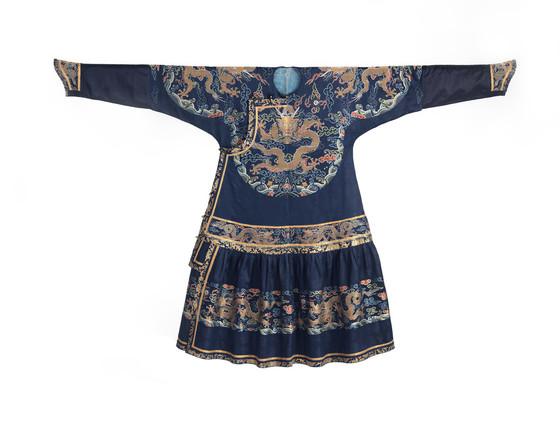In 1644 the Manchu army swept into Beijing to claim the Dragon Throne from the Han Chinese Ming dynasty (1368–1644). The Manchu had established their own Qing dynasty in the 1630s and would rule the Chinese empire until 1911. To celebrate their cultural and national identity in preparation for the conquest, the Manchu reconfigured the shape and construction of the imperial court wardrobe; however, the decorative patterning of newly designed archetypes maintained traditional iconographies of Chinese imperial authority and good fortune.
This exemplary formal court robe, known as chaopao, replaced the voluminous Han Chinese robes worn by Ming dynasty emperors and courtiers. The chaopao was required dress for the most important ritual functions held within the Forbidden City or at the sacrificial altars located on the cardinal point outside the capital. Its use was restricted to the Qing emperor and only highest-ranking male courtiers. Structurally, the chaopao retained vestiges of Manchu nomadic garments. Its overlapping front closure with loop-and-button fasteners and long tapered tripartite sleeves finished with “horse hoof” cuffs (ma ti xiu) recalled the pre-conquest riding coats of Manchu equestrians. The attached gathered skirt also referenced the clothing worn by warrior-huntsmen; composed of two overlapping rectangular pieces of silk cloth, its fullness allowed for ease of movement necessary for riding a horse.
Chaopao are embellished with strategically placed dragons—four arranged within a quatrefoil around the neck opening and dragons within bands at the waist and lower skirt. This design lexicon for Manchu clothing was influenced by diplomatic gifts of textiles and robes from Ming dynasty emperors to Manchu chieftains during the 16th century. The gifted robes and yardages were recut and remade into garments that appealed to the recipient’s taste. As a result, the distinctive Ming quatrefoil and band decor of dragons were preserved on Qing chaopao.
The materials, colors, and motifs of Qing court attire were strictly controlled by imperial regulation. Blue was declared the Qing dynastic color, replacing Ming dynasty red. While the color of the emperor’s robes changed with the requirements of season or occasion, all courtiers wore dark blue robes when in attendance at these events. Dragons, the mythical composite animals that symbolize imperial power, signaled an individual’s rank. As seen on this chaopao, dragons were depicted amidst clouds hovering above a cosmic landscape of waves crashing against stylized mountains.
This magnificent chaopao is composed of indigo-dyed blue silk damask patterned with dragon roundels and clouds that seamlessly transitions into areas of silk satin brocaded with colored silk- and gold-thread five-claw dragons. The frontal facing five-claw dragons within the quatrefoil yoke mark this garment as one for a high-ranking imperial prince. According to Chinese textile specialist John E. Vollmer, it is the only comparable early 18th-century chaopao outside of the Palace Museum in Beijing’s Forbidden City. This exceptional and rare chaopao will be highlighted in a major textile exhibition organized by LACMA in September 2018.
During our 31st annual Collectors Committee Weekend (April 21–22), members of LACMA's Collectors Committee generously helped the museum acquire nine works of art spanning a breadth of eras and cultures. Check back tomorrow to learn about another acquisition.



